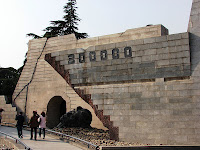


We flew from Xian, China to Nanjing and checked into the Crowne Plaza Hotel. Hotels in China are quite reasonable. The hotel is a high rise building where the bottom seven floors make up a shopping mall with high end shops like Dior, Rolex, and Swarovski. I was amazed with the number of malls in all the cities we visited featuring exclusively expensive shops where there were many shoppers. I had heard of the knock-off items from China but we never saw anyplace offering such items. I am sure they were available and while we didn’t seek them out we never saw a place to buy knock-off items. Our room on the 28th floor gave us a good view of the city which is about the size of New York City.
It is interesting how one thing leads to another. When John and I were planning our destinations in China, Nanjing was not on our original itinerary. However, that changed after we watched the movie, “John Rabe.” I had heard of what is usually referred to as the “Nanking Massacre” but I knew very little about it and much of what I did know I had forgotten. The movie refreshed my memory. In December 1937 the Japanese Imperial Army marched into Nanking (now written Nanjing), which was at that time the capital city of China. In six weeks the Japanese killed 300,000 civilians and soldiers out of the 600,000 people who had remained in the city. John Rabe was a German businessman working for the Seimens company and had lived in China with his family for many years. He used his position at Seimens and his membership in the German Nazi party to shelter 200,000 Chinese people by creating and heading up the Nanking Safety Zone thus saving their lives.
We visited the Nanjing Memorial Hall built on the site of one of the massacres. One section is dedicated to the foreigners who stayed behind to help. Along with Rabe there were several Americans educators, missionaries, and businessmen who also helped including Minnie Vautrin, an American missionary and teacher credited with protecting up to 10,000 women at Ginling Girls College which she helped to found.
Another American, Claire L. Chennault who created the Flying Tigers, was also featured. The American volunteer group of fighter pilots helped to protect the Chinese from Japanese air raids. Months before while visiting a museum in Lake Charles, Louisiana, Chennault’s hometown, there was a display devoted to Chennault, I overheard a Chinese-American visitor proclaim, “Chennault! He is famous in China. Every Chinese student learns about him and the Flying Tigers.”
While chatting with one of the hotel’s staff I mentioned that I like to visit schools. She connected me with an English training center near the hotel. It was very impressive. Parents, who can afford to, send their children to school in the evenings and weekends to learn English. The school, Jump A-Z, was on the 10th floor of a financial center. They have over 1000 students from three to 14 years old who are learning to speak English after attending regular school all day. An excellent command of the English language is considered necessary for future success. The school was bright and beautiful with state-of-the art equipment. I was extremely impressed with the facility. I presented a power point program I have presented in many places depicting schools around the world.